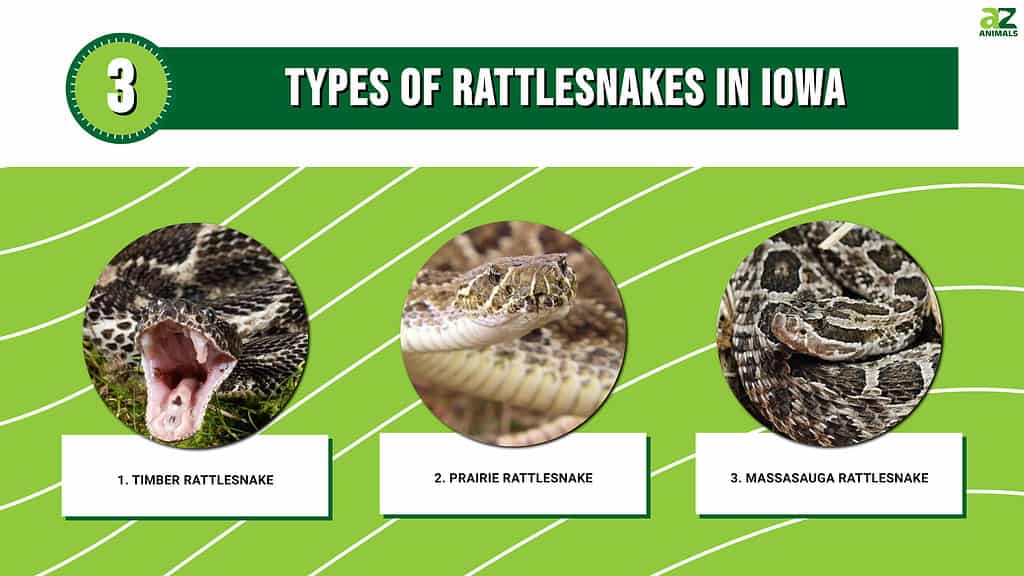
Within the vast prairies and corn fields across the state of Iowa live at least 28 different species of snakes. Other than garter snakes, all snake species are protected by Iowa state laws, which means they cannot be killed, caught, or collected.

Iowa (U.S. state) flag
©railway fx/Shutterstock.com
In fact, only three of the four venomous snake species in Iowa are rattlesnakes, and they are pretty rare in the state. That means if you come across a snake in Iowa, it is most likely not a rattlesnake. However, it is useful to know how to identify rattlesnakes to help you stay safe, so let’s take a closer look at the three types of rattlesnakes in Iowa!
1. Timber Rattlesnake
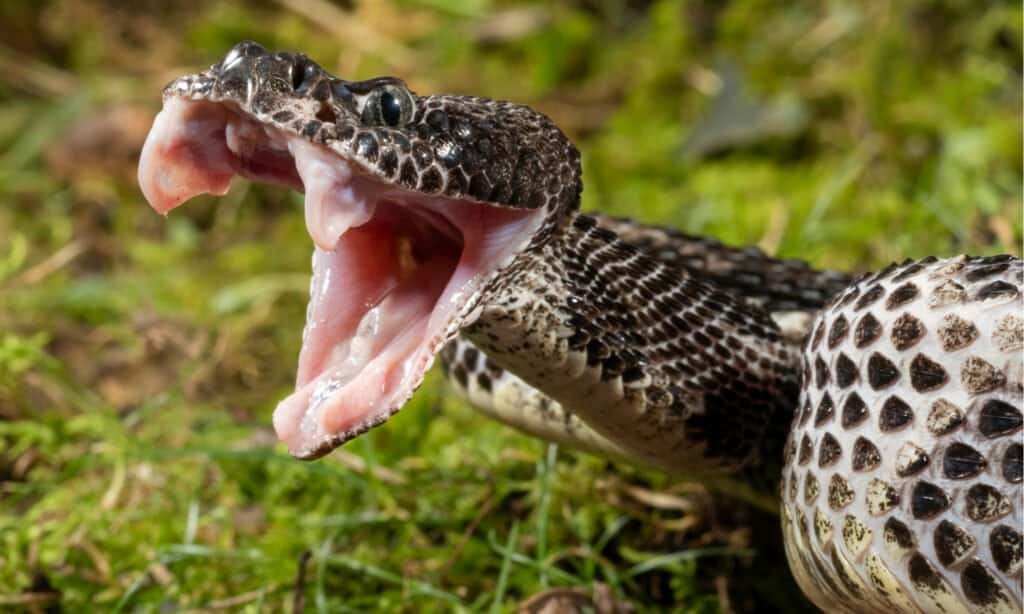
Timber rattlesnakes are among the most venomous snakes in the United States.
©Joe McDonald/Shutterstock.com
| Timber Rattlesnake | |
|---|---|
| Range | Eastern & Southeastern Edges of Iowa |
| Length | 36-60 inches |
If you find a rattlesnake in Iowa, it will most likely be a timber rattlesnake. Timber rattlesnakes live in pockets along the eastern and southeastern edges of Iowa and are protected by state laws. These snakes prefer to live and den in wooded areas and along rocky slopes and often bask in the sun on warm rocks. They also spend much of the year in hibernation dens to avoid the cold. Human development and construction in these areas have threatened their habitats, and over the past 30 years, their populations have decreased by over fifty percent.
The large size and toxic venom of timber rattlesnakes make them some of the most dangerous snakes in North America. However, timber rattlesnakes usually give noticeable warnings prior to striking by vibrating the large rattles on their tails. It takes a lot to get timber rattlesnakes to bite. Sometimes, they may even feign a strike before actually biting.
Although they are very dangerous, timber rattlesnakes are also shy and docile. They avoid humans as much as possible and rarely bite. As long as you avoid getting too close to these snakes and leave them alone, they usually do not cause any trouble.
Timber rattlesnakes have gold, tan, brown, or gray bodies with distinct black chevron-shaped bands along the length of their bodies. Many timber rattlesnakes in Iowa have an additional thin stripe running down the center of their backs that is rust or orange-brown. They are easily distinguished from massasaugas and prairie rattlesnakes because their tails are velvet-black on end, tipped with a light-colored rattle. Timber rattlesnakes are 36-60 inches long with thick bodies and large, spade-shaped heads.
2. Prairie Rattlesnake
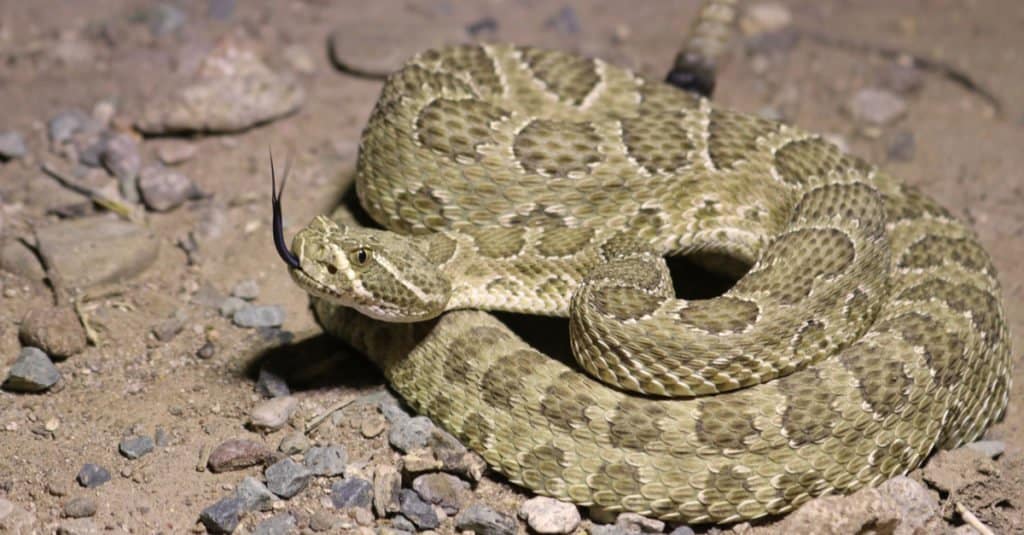
Prairie rattlesnakes get their name because they prefer to live in prairie regions.
©Creeping Things/Shutterstock.com
| Prairie Rattlesnake | |
|---|---|
| Range | In & Around Broken Kettle Grasslands Preserve |
| Length | 35-45 inches |
Prairie rattlesnakes are an endangered species in Iowa. They only live in a small area in and around the Broken Kettle Grasslands Preserve, Iowa’s largest continuous native prairie. These snakes prefer to live in large and open prairies and grasslands. Prairie rattlesnakes need large prairie regions because they travel long distances in search of food and mates, often 5-6 miles away from their hibernation dens.
There are no other rattlesnake species that live within the range of prairie rattlesnakes in Iowa, so they are easy to identify. These snakes grow between 35-45 inches in length and have large heads that are shaped like a spade or large triangle. There are two lighter stripes on each side of the snakes’ heads, and their eyes have elliptical pupils like a cat’s. Their bodies can be brown, tan, greenish-brown, or greenish-gray, with dark brown rounded blotches running along their backs.
Fortunately, prairie rattlesnakes are not quick to bite. Most of the time, they will not strike unless they are provoked. These snakes eat birds, bird eggs, and small mammals like ground squirrels and rodents. Juvenile snakes will often hunt reptiles and amphibians as well. Prairie rattlesnakes prefer to stay on the ground, but they have been known to climb into bushes or up trees occasionally.
3. Massasauga Rattlesnake
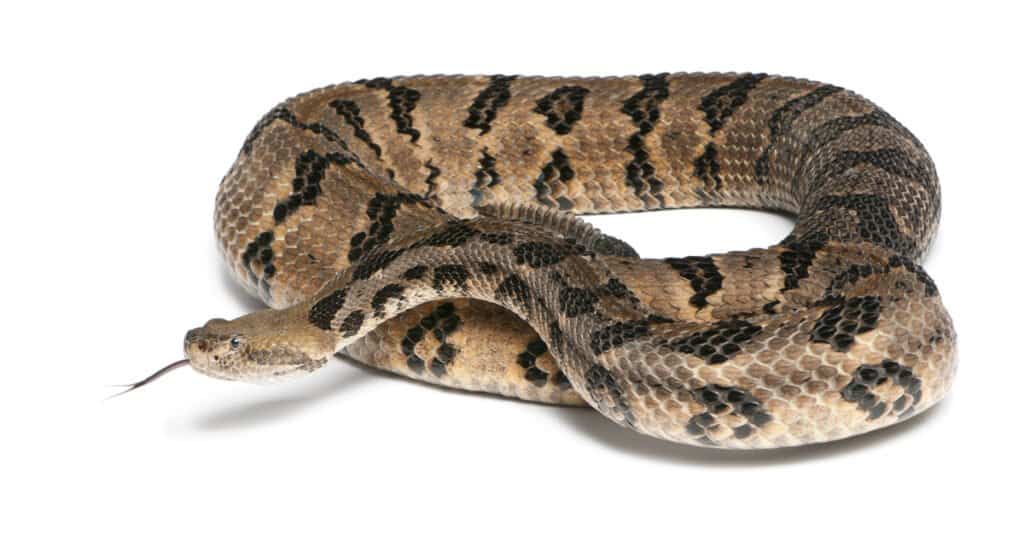
Massasauga rattlesnakes have very small rattles on the end of their tails.
©fivespots/Shutterstock.com
| Massasauga Rattlesnake | |
|---|---|
| Range | Rare, Small Populations Across Iowa |
| Length | 18-30 inches |
Massasauga rattlesnakes are extremely rare in Iowa. There are only a handful of small populations scattered across the state. These snakes utilize a wide variety of habitats like old fields, sedge meadows, prairies, pastures, wet grasslands, and bottomland forests. They migrate between different habitats depending on the time of year.
For example, from April to November, massasauga rattlesnakes primarily live in upland areas. They commonly slither across roads in the late summer months, between July and September, as they hunt for small snakes and mammals like shrews and mice. When it gets too cold for them in the winter, they move to adjacent wetlands where they brumate (similar to hibernating) in small mammals and crayfish burrows. Because they require a variety of habitats and a great deal of space, massasaugas are threatened with habitat loss due to human activities and agricultural development.
There are two subspecies of massasauga rattlesnakes in Iowa: the eastern massasauga and the western massasauga. However, both subspecies look extremely similar and can be identified by the same features. Massasaugas are smaller than the other rattlesnakes in Iowa, growing only between 18-30 inches long. They have stout gray or grayish-brown bodies with dark blotches (or sometimes bands) along their backs and smaller spots along their sides. Near the end of the tail, there are dark bands instead of blotches, just before the snakes’ small rattles. These snakes also have large spade-shaped heads, although they are not as big as other rattlesnakes.
What To Do If You Encounter A Rattlesnake In Iowa
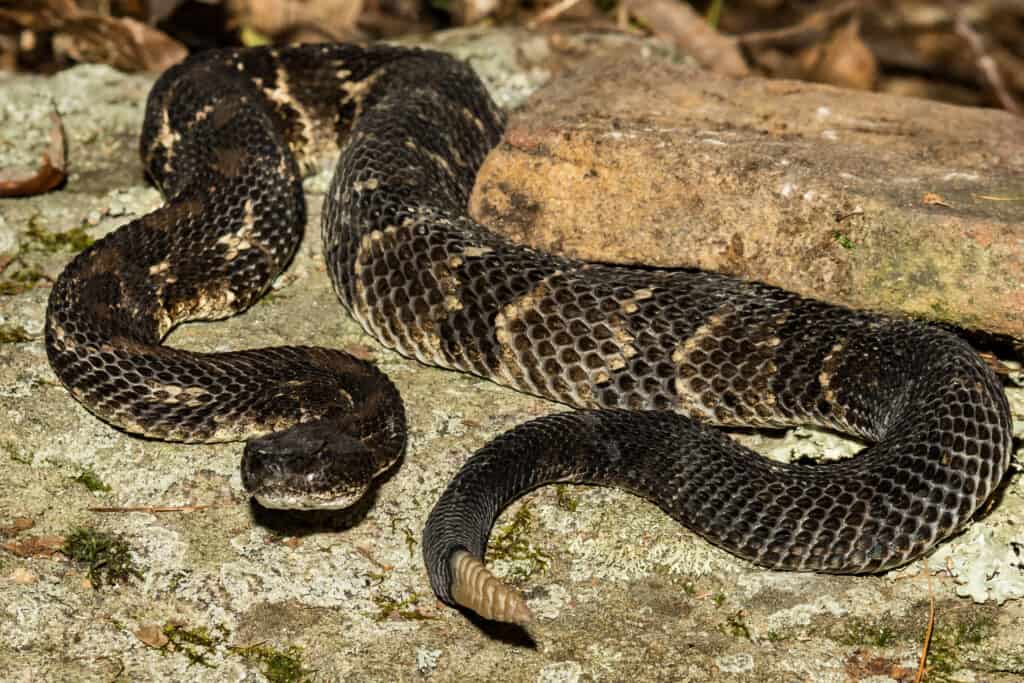
Rattlesnakes are vital to keeping ecosystems balanced, and they provide excellent pest control.
©iStock.com/JasonOndreicka
Rattlesnakes are vital to keeping ecosystems balanced, and they provide excellent pest control. Although, they are dangerous and should not keep you from enjoying the beauty of the outdoors in Iowa. It is always best to be prepared, so here are a few ways to stay safe from rattlesnakes in Iowa:
- Be aware and always take a careful look at your surroundings. The rattlesnakes in Iowa are not very aggressive and try to stay out of sight. This means that you may not see them right away. Rattlesnakes often hide in rock crevices or under logs and rocks. Always check before placing your hand down near these areas.
- Wear sturdy shoes and long pants to protect your feet and legs. Also, watch where you step. Many rattlesnake bites happen because someone did not see the snake and accidentally stepped on it.
- If you do see a rattlesnake, do not interact with it. If the snake is on the move, wait and let it pass. If it is coiled and resting, give it a wide berth and do not bother it. If you see a dead rattlesnake, leave it alone. Even a dead rattlesnake can reflexively bite with venom.
Summary of the 3 Types of Rattlesnakes in Iowa
| # | Rattlesnake | Length |
|---|---|---|
| 1 | Timber Rattlesnake | 36 – 60 inches |
| 2 | Prairie Rattlesnake | 35 – 45 inches |
| 3 | Massasauga Rattlesnake | 18 – 30 inches |
The photo featured at the top of this post is © Max Allen/Shutterstock.com
Discover the "Monster" Snake 5X Bigger than an Anaconda
Every day A-Z Animals sends out some of the most incredible facts in the world from our free newsletter. Want to discover the 10 most beautiful snakes in the world, a "snake island" where you're never more than 3 feet from danger, or a "monster" snake 5X larger than an anaconda? Then sign up right now and you'll start receiving our daily newsletter absolutely free.
Thank you for reading! Have some feedback for us? Contact the AZ Animals editorial team.






